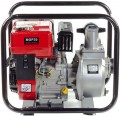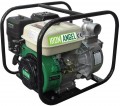Maximum head
The maximum head generated by the pump. This parameter is most often indicated in meters, by the height of the water column that the unit can create — in other words, by the height to which it can supply water. You can estimate the pressure created by the pump using a simple formula: every 10 m of head corresponds to a pressure of 1 bar.
It is worth choosing a pump according to this parameter, taking into account the height to which it should supply water, as well as adjusting for losses and the need for pressure in the water supply. To do this, it is necessary to determine the difference in height between the water level and the highest point of water intake, add another 10 to 30 m to this figure (depending on the pressure that needs to be obtained in the water supply), and multiply the result by 1.1 — this will be the minimum pressure required.
Suction height
The largest difference between the height of the pump and the height of the water level at which the pump can provide normal suction. Without special devices, the maximum value of this parameter is 7-8 m — this is due to the physics of the process. However, when using an ejector (see below), the suction height can be increased several times.
Maximum particle size
The largest particle size that the pump can handle without problems. This size is the main indicator that determines the purpose of the device (see above); and in general, the larger it is, the more reliable the device, the lower the risk of damage if a foreign object enters the suction line. If the risk of the appearance of too large mechanical impurities is still high, additional protection can be provided with filters or grids at the inlet. However, such a measure should be considered only as a last resort, because from constant exposure to solid particles, the grids become clogged and deformed, which can lead to both clogging of the line and filter breakthrough.
Maximum liquid temperature
The highest temperature of water at which the pump is capable of operating normally. Usually, in most models this parameter is 35-40 °C — at high temperatures it is difficult to ensure effective cooling of the engine and moving parts, and in fact, such conditions are rare.
Dry run protection
A system that protects the unit from running without water.
The dry running mode is abnormal for any pump: at best, the mechanism of the unit in this mode experiences increased loads, and at worst, the device may fail and even a serious accident. This feature allows you to prevent such consequences. The specific method of protection against dry running may be different; one of the most popular options is a float switch (see below). However, in addition, flow sensors, pressure or level switches can be used. These details depend both on the general type of pump and on the specific model; they should be specified separately in each case.
Maximum power
Rated power of the pump motor. The more powerful the engine, the higher the performance of the unit, usually, the greater the pressure, suction height, etc. Of course, these parameters largely depend on other features (primarily the pump type, see above); but models similar in design can be compared in terms of power.
Note that high power, usually, increases the size, weight and cost of the pump, and also implies high costs of electricity or fuel (see "Power source"). Therefore, it is worth choosing a pump according to this parameter taking into account the specific situation; more detailed recommendations can be found in special sources.
Хар-ки двигателя
Country of origin
Country of origin of the brand under which the pump is marketed.
There are many stereotypes related to how the origin of goods from a particular country affects their quality. However, these stereotypes are unfounded. Firstly, this paragraph does not indicate the actual place of production of the unit, but the "homeland" of the trademark (or the location of the manufacturer's headquarters); production facilities may be located in another country. Secondly, the actual quality of the product depends not so much on geography, but on the organization of processes within a particular company. So when choosing, it is best to focus not so much on the "nationality" of the pump, but on the overall reputation of a particular brand. And paying attention to the country of origin makes sense if you fundamentally want (or do not want) to support a manufacturer from a certain state.
Impeller / auger material
The material from which the main working element of the pump is made is an impeller, an auger or a membrane. This part is in direct contact with the pumped liquid, so its specs are key to the overall performance and capabilities of the pump.
— Plastic. Plastic is low-cost, and it is not subject to corrosion. It is believed that the mechanical strength of this material is generally low, and it does not tolerate contact with solid impurities. However, today there are many varieties of plastic — including special high-strength varieties that are suitable even for working with heavily polluted water or sewage. So plastic impellers/augers can be found in a variety of types of pumps; the overall quality and reliability of such parts, usually, depend on the price category of the unit.
— Cast iron. Solid, durable, reliable and, at the same time, relatively inexpensive material. In terms of corrosion resistance, cast iron is theoretically inferior to more advanced alloys like stainless steel or aluminium; however, subject to the operating rules, this point is not critical, and the service life of cast iron parts is no less than the total service life of the pump. The unequivocal disadvantages of this option include a large mass, which slightly increases the energy/fuel consumption during operation.
— Stainless steel. By the name, one of the key advantages of stainless steel is high resistance to corrosion — and, accordingly, reliability and durabili...ty. Such an alloy is somewhat more expensive than cast iron, but it also weighs less.
— Aluminium. Aluminium alloys combine strength, reliability, corrosion resistance and low weight. However, such materials are quite expensive — more expensive than the same stainless steel, not to mention cast iron.
— Brass. The varieties of brass used in pumps are distinguished by high strength and hardness, as well as insensitivity to moisture. Such materials are quite expensive, but this price is fully justified by the mentioned advantages. Therefore, in certain types of pumps — in particular, surface models and pressure tank units — brass impellers are very popular.
— Bronze. A material similar in many properties to the brass described above. However, bronze is used much less frequently — in particular, due to a slightly higher cost.
— Steel. Varieties of steel that are not related to stainless steel are used extremely rarely — in certain models of pumps for chemical liquids. At the same time, steel is usually used as a base in such parts, and a coating of fluoroplastic or other similar material is applied to it to protect it from corrosion.
— Silumin. Silumins are called aluminium alloys with the addition of silicon. For several reasons, such materials are rare in pumps, and mainly among relatively inexpensive models.
— Rubber. Material traditionally used for diaphragms in vibratory pumps (see “Pump type”).

